初中全新英语语法——被动语态(共23张PPT)
文档属性
| 名称 | 初中全新英语语法——被动语态(共23张PPT) |  | |
| 格式 | ppt | ||
| 文件大小 | 3.0MB | ||
| 资源类型 | 教案 | ||
| 版本资源 | 通用版 | ||
| 科目 | 英语 | ||
| 更新时间 | 2022-04-10 10:59:16 | ||
图片预览

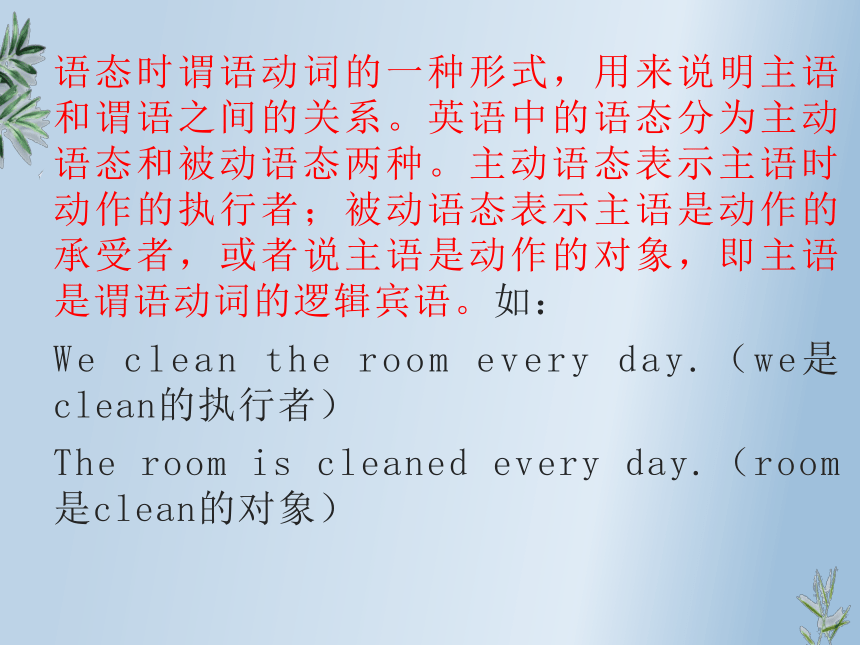
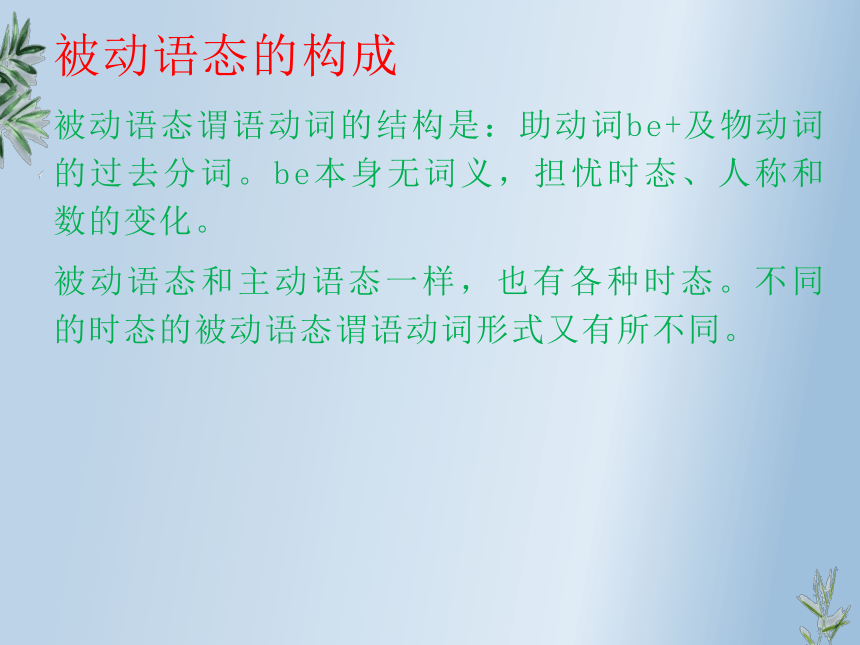

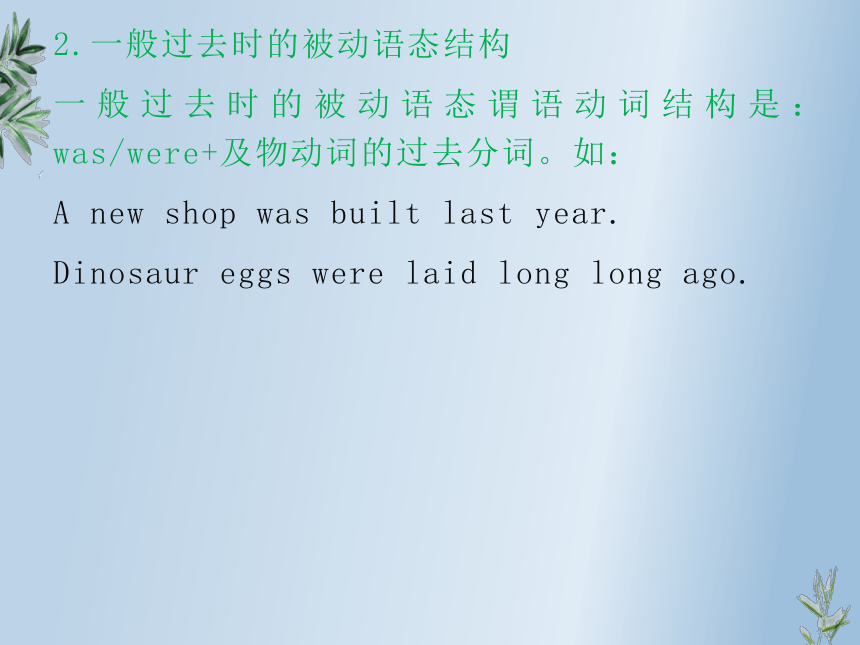


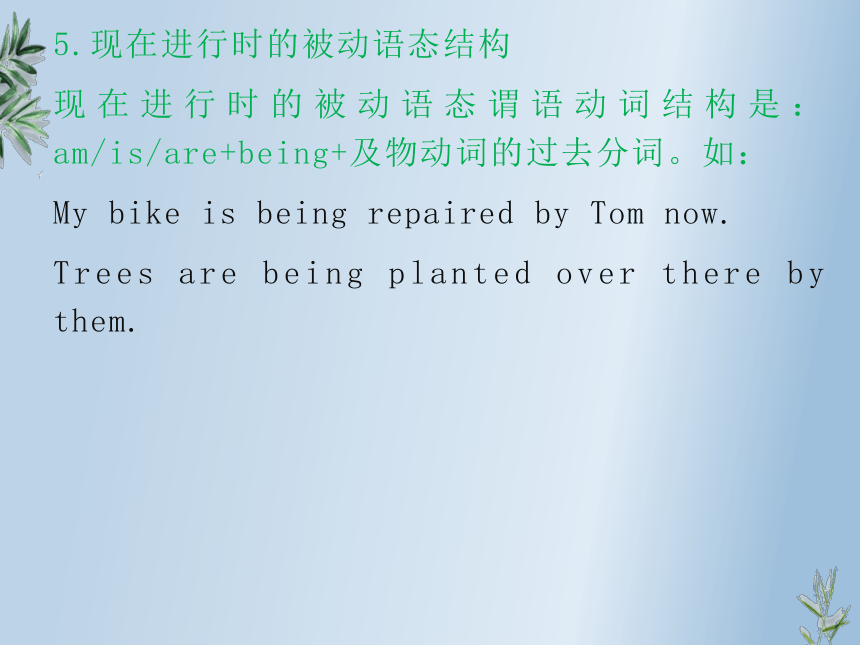
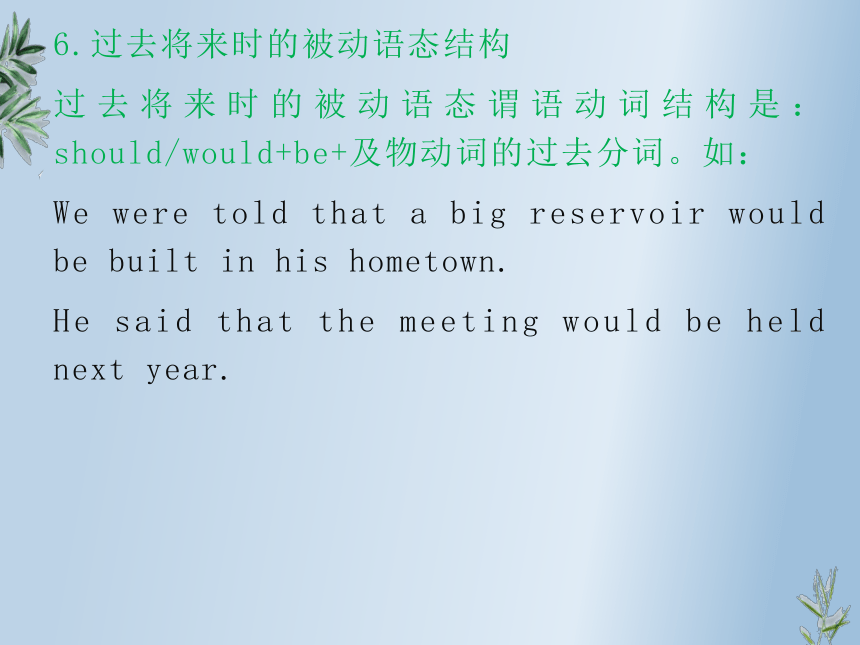
文档简介
(共23张PPT)
初中全新英语语法
被动语态
语态时谓语动词的一种形式,用来说明主语和谓语之间的关系。英语中的语态分为主动语态和被动语态两种。主动语态表示主语时动作的执行者;被动语态表示主语是动作的承受者,或者说主语是动作的对象,即主语是谓语动词的逻辑宾语。如:
We clean the room every day.(we是clean的执行者)
The room is cleaned every day.(room是clean的对象)
被动语态的构成
被动语态谓语动词的结构是:助动词be+及物动词的过去分词。be本身无词义,担忧时态、人称和数的变化。
被动语态和主动语态一样,也有各种时态。不同的时态的被动语态谓语动词形式又有所不同。
1.一般现在时的被动语态结构
一般现在时的被动语态谓语动词结构是:am/is/are+及物动词的过去分词。如:
Our classroom is cleaned everyday.
I am asked to study hard.
Knives are used for cutting things.
2.一般过去时的被动语态结构
一般过去时的被动语态谓语动词结构是:was/were+及物动词的过去分词。如:
A new shop was built last year.
Dinosaur eggs were laid long long ago.
3.一般将来时的被动语态结构
一般将来时的被动语态谓语动词结构是:will/shall+be+及物动词的过去分词。如:
A new hospital will be built in our city.
Many more trees will be planted next year.
4.现在完成时的被动语态结构
现在完成时的被动语态谓语动词结构是:have/has+been+及物动词的过去分词。如:
The book has been translated into many languages.
Many man-made satellites have been sent up into space by many countries.
5.现在进行时的被动语态结构
现在进行时的被动语态谓语动词结构是:am/is/are+being+及物动词的过去分词。如:
My bike is being repaired by Tom now.
Trees are being planted over there by them.
6.过去将来时的被动语态结构
过去将来时的被动语态谓语动词结构是:should/would+be+及物动词的过去分词。如:
We were told that a big reservoir would be built in his hometown.
He said that the meeting would be held next year.
7.过去进行时的被动语态结构
过去进行时的被动语态谓语动词结构是:were/was+being+及物动词的过去分词。如:
He said that the man was being operated on.
He told me that a new station was being built there.
8.过去完成时的被动语态结构
过去完成时的被动语态谓语动词结构是:had+been+及物动词的过去分词。如:
He said that the work had been finished.
When I got to the theater,I found the tickets had already been sold out.
9.含有情态动词的被动语态结构
含有情态动词的被动语态谓语动词结构是:情态动词+be+及物动词的过去分词。如:
Young trees must be watered often.
Your mistakes should be corrected right now.
The door may be locked inside.
Your homework can be handed in tomorrow.
被动语态的用法
1.动作的执行者不明确用被动语态
当我们不知道动作的执行者是谁,或没有必要指出动作的执行者是谁时用被动语态。如:
The glass is broken.
Letters are collected at eight every morning.
His bike has been stolen.
2.动作的承受者是谈话的中心时用被动语态
为了强调或突出动作的承受者,使动作的承受者成为谈话的中心时用被动语态。如:
The desk was made by Master Wang.
The bag was taken away by his sister.
The man was hit by a speeding car.
The plan has already been made.
主动语态与被动语态的转换
主动语态的句子可以变成被动语态的句子。在由主动语态变为被动语态时,要注意被动语态中的人称和数要与被动语态的谓语动词保持一致;被动语态要与主动语态的时态保持一致。主动语态与被动语态的装换主要有以下几种情况。
1.“主+谓+宾”结构
(1)把主动的宾语变为被动句的主语;
(2)把主动句的谓语动词变为be+过去分词形式;
(3)把主动句的主语放到介词by后面组成介词短语,置于被动句后作状语;
2.“主+谓+间宾+直宾”结构
(1)将间接宾语变为被动语态的主语,直接宾语保留在动词后不变。如:
They offered me a job in the company.
→I was offered a job in the company.
Li Hua showed me his new shoes.
→I was showed his new shoes by Li Hua.
(2)将直接宾语变为被动语态的主语,谓语动词与间接宾语时间要加上介词to或for。如:
Father gave me a nice present.
→A nice present was given to me by father.
Mr.Lin booked me a room in the hotel.
→A room was booked for me by Mr.Lin in the hotel.
3.“主+谓+宾语+宾补”结构
含有复合宾语(宾语+宾语补足语)的主动句变为被动句时,将主动的宾语变为被动句的主语,而主动句中的宾语补足语保留不动,成为主语补足语。常见动词有:call,make,choose,regard,name,believe,paint,think等。如:
We painted the wall white.
→The wall was painted white by us.
不用被动语态的情况
(1)某些谓语动词在句中为连系动词时,不用被动语态。如:
He looked fine.
The food tastes delicious.
(2)谓语动词为不及物动词或不及物的短语动词时,不用被动语态。如:
The war broke out in the end.
I happened to meet him there.
(3)宾语为动词不定式、动词的-ing形式或从句,表示主语的一些想法、爱好或愿望时,一般不用被动语态。如:
He decided to go with us.
I want to buy a computer.
(4)宾语时相互代词、反身代词、同源宾语等时,一般不用被动语态。如:
We should help each other.
He thinks of himself too much.
主动形式表示被动意义的情况
(1)有些及物动词形式上虽为主动,但表示被动意义。如:
The plan worked out successfully.
=The plan was worked out successfully.
The book sells well.
This shirt will wear very long.
Meat cuts easily.
The parcel carries easily.
The fields flooded.
Pipe oranges peel easily.
(2)有些动词的进行时,形式上是主动,但含被动的意义。如:
The book is printing. =The book is being printed.
The house is building. =The house is being built.
The drum is beating. =The drum is being beaten.
(3)有些介词短语作表语时,主动形式表示被动意义。如:
The question is now under discussion.
The fire was finally under control.
All these temples are under repairs.
The project is in the charge of a Japanese expert.
初中全新英语语法
被动语态
语态时谓语动词的一种形式,用来说明主语和谓语之间的关系。英语中的语态分为主动语态和被动语态两种。主动语态表示主语时动作的执行者;被动语态表示主语是动作的承受者,或者说主语是动作的对象,即主语是谓语动词的逻辑宾语。如:
We clean the room every day.(we是clean的执行者)
The room is cleaned every day.(room是clean的对象)
被动语态的构成
被动语态谓语动词的结构是:助动词be+及物动词的过去分词。be本身无词义,担忧时态、人称和数的变化。
被动语态和主动语态一样,也有各种时态。不同的时态的被动语态谓语动词形式又有所不同。
1.一般现在时的被动语态结构
一般现在时的被动语态谓语动词结构是:am/is/are+及物动词的过去分词。如:
Our classroom is cleaned everyday.
I am asked to study hard.
Knives are used for cutting things.
2.一般过去时的被动语态结构
一般过去时的被动语态谓语动词结构是:was/were+及物动词的过去分词。如:
A new shop was built last year.
Dinosaur eggs were laid long long ago.
3.一般将来时的被动语态结构
一般将来时的被动语态谓语动词结构是:will/shall+be+及物动词的过去分词。如:
A new hospital will be built in our city.
Many more trees will be planted next year.
4.现在完成时的被动语态结构
现在完成时的被动语态谓语动词结构是:have/has+been+及物动词的过去分词。如:
The book has been translated into many languages.
Many man-made satellites have been sent up into space by many countries.
5.现在进行时的被动语态结构
现在进行时的被动语态谓语动词结构是:am/is/are+being+及物动词的过去分词。如:
My bike is being repaired by Tom now.
Trees are being planted over there by them.
6.过去将来时的被动语态结构
过去将来时的被动语态谓语动词结构是:should/would+be+及物动词的过去分词。如:
We were told that a big reservoir would be built in his hometown.
He said that the meeting would be held next year.
7.过去进行时的被动语态结构
过去进行时的被动语态谓语动词结构是:were/was+being+及物动词的过去分词。如:
He said that the man was being operated on.
He told me that a new station was being built there.
8.过去完成时的被动语态结构
过去完成时的被动语态谓语动词结构是:had+been+及物动词的过去分词。如:
He said that the work had been finished.
When I got to the theater,I found the tickets had already been sold out.
9.含有情态动词的被动语态结构
含有情态动词的被动语态谓语动词结构是:情态动词+be+及物动词的过去分词。如:
Young trees must be watered often.
Your mistakes should be corrected right now.
The door may be locked inside.
Your homework can be handed in tomorrow.
被动语态的用法
1.动作的执行者不明确用被动语态
当我们不知道动作的执行者是谁,或没有必要指出动作的执行者是谁时用被动语态。如:
The glass is broken.
Letters are collected at eight every morning.
His bike has been stolen.
2.动作的承受者是谈话的中心时用被动语态
为了强调或突出动作的承受者,使动作的承受者成为谈话的中心时用被动语态。如:
The desk was made by Master Wang.
The bag was taken away by his sister.
The man was hit by a speeding car.
The plan has already been made.
主动语态与被动语态的转换
主动语态的句子可以变成被动语态的句子。在由主动语态变为被动语态时,要注意被动语态中的人称和数要与被动语态的谓语动词保持一致;被动语态要与主动语态的时态保持一致。主动语态与被动语态的装换主要有以下几种情况。
1.“主+谓+宾”结构
(1)把主动的宾语变为被动句的主语;
(2)把主动句的谓语动词变为be+过去分词形式;
(3)把主动句的主语放到介词by后面组成介词短语,置于被动句后作状语;
2.“主+谓+间宾+直宾”结构
(1)将间接宾语变为被动语态的主语,直接宾语保留在动词后不变。如:
They offered me a job in the company.
→I was offered a job in the company.
Li Hua showed me his new shoes.
→I was showed his new shoes by Li Hua.
(2)将直接宾语变为被动语态的主语,谓语动词与间接宾语时间要加上介词to或for。如:
Father gave me a nice present.
→A nice present was given to me by father.
Mr.Lin booked me a room in the hotel.
→A room was booked for me by Mr.Lin in the hotel.
3.“主+谓+宾语+宾补”结构
含有复合宾语(宾语+宾语补足语)的主动句变为被动句时,将主动的宾语变为被动句的主语,而主动句中的宾语补足语保留不动,成为主语补足语。常见动词有:call,make,choose,regard,name,believe,paint,think等。如:
We painted the wall white.
→The wall was painted white by us.
不用被动语态的情况
(1)某些谓语动词在句中为连系动词时,不用被动语态。如:
He looked fine.
The food tastes delicious.
(2)谓语动词为不及物动词或不及物的短语动词时,不用被动语态。如:
The war broke out in the end.
I happened to meet him there.
(3)宾语为动词不定式、动词的-ing形式或从句,表示主语的一些想法、爱好或愿望时,一般不用被动语态。如:
He decided to go with us.
I want to buy a computer.
(4)宾语时相互代词、反身代词、同源宾语等时,一般不用被动语态。如:
We should help each other.
He thinks of himself too much.
主动形式表示被动意义的情况
(1)有些及物动词形式上虽为主动,但表示被动意义。如:
The plan worked out successfully.
=The plan was worked out successfully.
The book sells well.
This shirt will wear very long.
Meat cuts easily.
The parcel carries easily.
The fields flooded.
Pipe oranges peel easily.
(2)有些动词的进行时,形式上是主动,但含被动的意义。如:
The book is printing. =The book is being printed.
The house is building. =The house is being built.
The drum is beating. =The drum is being beaten.
(3)有些介词短语作表语时,主动形式表示被动意义。如:
The question is now under discussion.
The fire was finally under control.
All these temples are under repairs.
The project is in the charge of a Japanese expert.
同课章节目录
- 词法
- 名词
- 动词和动词短语
- 动词语态
- 动词时态
- 助动词和情态动词
- 非谓语动词
- 冠词
- 代词
- 数词和量词
- 形容词副词及其比较等级
- 介词和介词短语
- 连词和感叹词
- 构词法
- 相似、相近词比较
- 句法
- 陈述句
- 一般疑问句和否定疑问句
- 特殊疑问句及选择疑问句
- 反意疑问句
- 存在句(There be句型)
- 宾语从句
- 定语从句
- 状语从句
- 主谓一致问题
- 简单句
- 并列句
- 复合句
- 主谓一致
- 主、表语从句
- 名词性从句
- 直接引语和间接引语
- 虚拟语气
- 感叹句
- 强调句
- 倒装句
- 祈使句
- 句子的成分
- 句子的分类
- 题型专区
- 单项选择部分
- 易错题
- 完形填空
- 阅读理解
- 词汇练习
- 听说训练
- 句型转换
- 补全对话
- 短文改错
- 翻译
- 书面表达
- 任务型阅读
- 语法填空
- 其他资料
